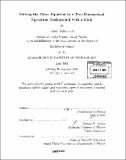Solving the Dirac equation in a two-dimensional spacetime background with a kink
Author(s)
Falkenbach, Jeffrey (Jeffrey C.)
DownloadFull printable version (2.116Mb)
Other Contributors
Massachusetts Institute of Technology. Dept. of Physics.
Advisor
Roman W. Jackiw.
Terms of use
Metadata
Show full item recordAbstract
In the following paper, I study the Dirac equation in curved spacetime and solve this equation in two-dimensional spacetime backgrounds discovered by Jackiw et al[4], [5]. I will first discuss flat spacetime and introduce the Dirac equation, which describes the relativistic wavefunctions of spin-1/2 particles. I will go on to discuss curved spacetime and introduce the Vierbein field, which will relate an arbitrary curved spacetime to the simpler fiat spacetime. After examining various transformation properties in curved and flat spacetime, I will use the properties to postulate the Dirac equation in arbitrary curved coordinates. By checking the invariance of the Dirac action under both coordinate and Lorentz transformations, I will verify that the postulated Dirac action satisies the proper symmetries and properties that it should. In order to solve the Dirac equation in the spacetime backgrounds found by Jackiw, I will need to examine the equation in the two- and three-dimensional cases. I will then reduce the three-dimensional Dirac equation to two dimensions to describe states independent of the third dimension, because the spacetime backgrounds were derived in an Ansatz which reduced the metric from three to two spacetime dimensions. (cont.) I will then be able to solve the reduced Dirac equation in each of four spacetime backgrounds. The solutions to the first three spacetime backgrounds involve spherical Bessel functions. The last spacetime background has a kink, and its solution involves a hyperbolic cosine function enveloping an oscillatory factor.
Description
Thesis (S.B.)--Massachusetts Institute of Technology, Dept. of Physics, 2005. Includes bibliographical references (p. 51).
Date issued
2005Department
Massachusetts Institute of Technology. Department of PhysicsPublisher
Massachusetts Institute of Technology
Keywords
Physics.